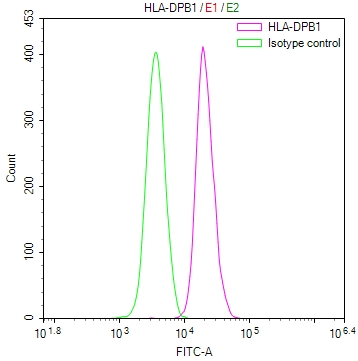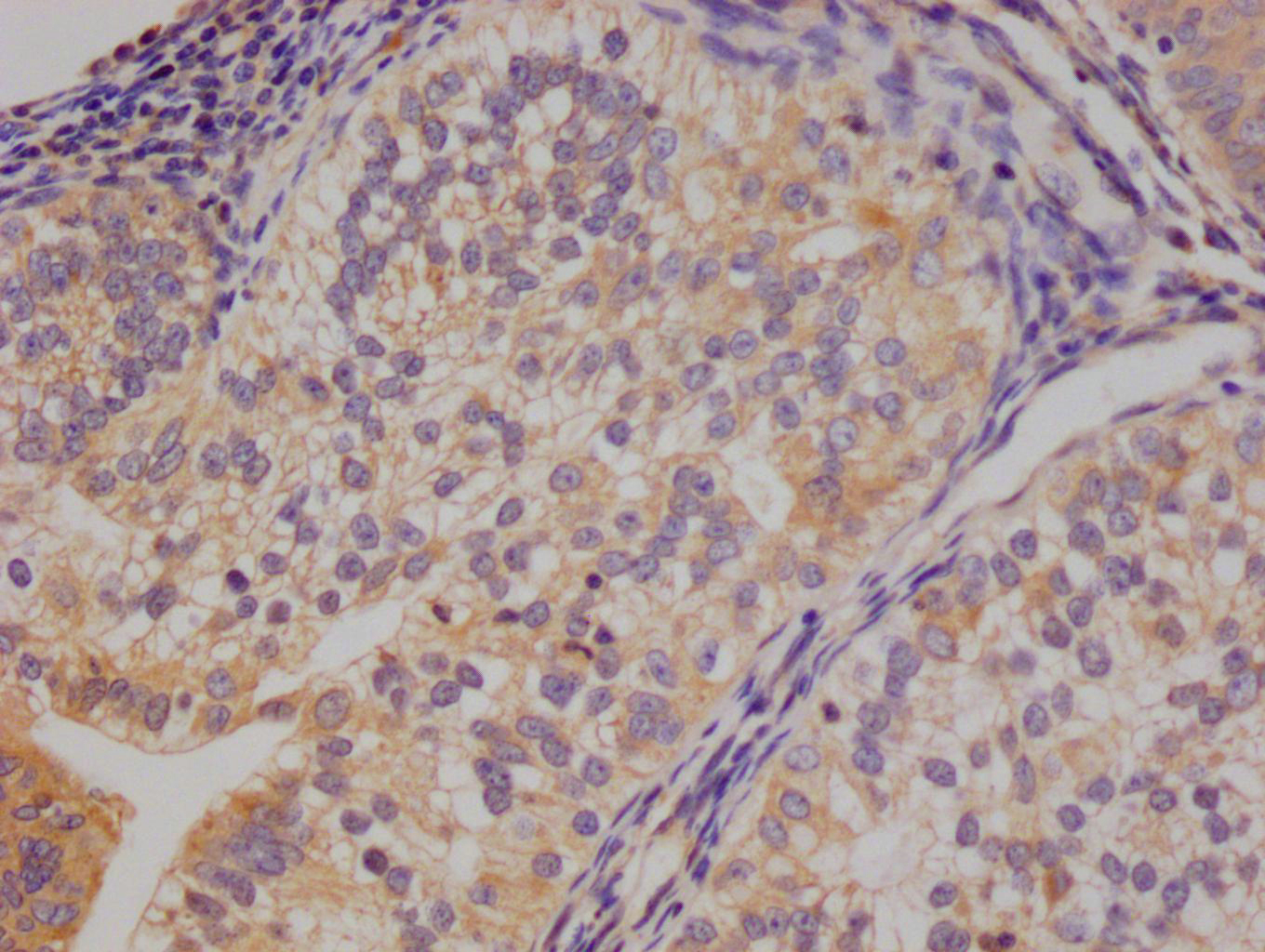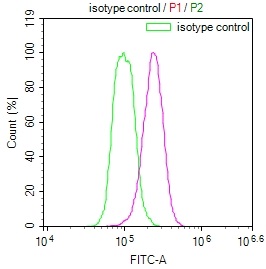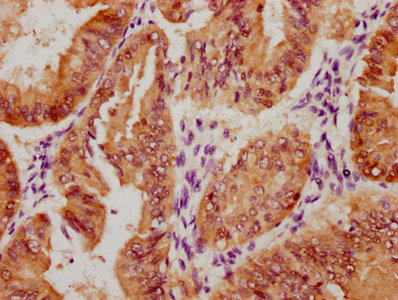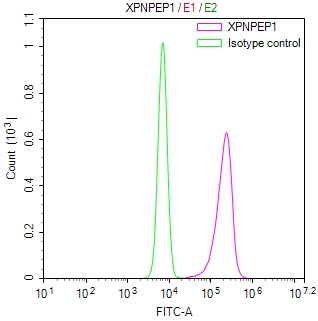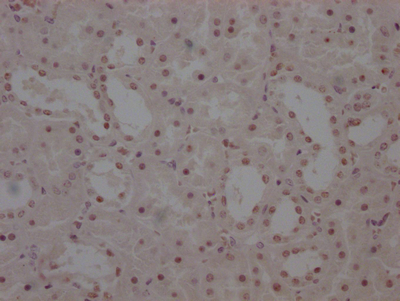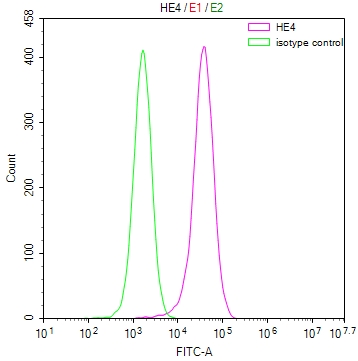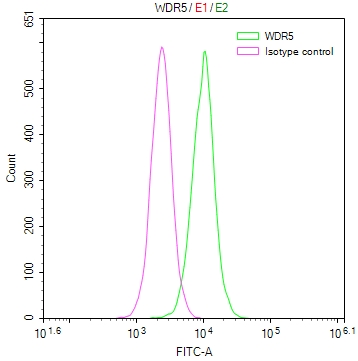HLA-DPB1 Recombinant Monoclonal Antibody
-
中文名稱:HLA-DPB1 Recombinant Monoclonal Antibody
-
貨號:CSB-RA727193A0HU
-
規(guī)格:¥1320
-
圖片:
-
Overlay Peak curve showing jurkat cells stained with CSB-RA727193A0HU (red line) at 1:100. The cells were fixed in 4% formaldehyde and permeated by 0.2% TritonX-100 for?10min. Then 10% normal goat serum to block non-specific protein-protein interactions followed by the antibody (1ug/1*106cells) for 45min at 4℃. The secondary antibody used was FITC-conjugated goat anti-rabbit IgG (H+L) at 1/200 dilution for 35min at 4℃.Control antibody (green line) was Rabbit IgG (1ug/1*106cells) used under the same conditions. Acquisition of >10,000 events was performed.
-
-
其他:
產(chǎn)品詳情
-
Uniprot No.:
-
基因名:
-
別名:HLA class II histocompatibility antigen, DP beta 1 chain (HLA class II histocompatibility antigen, DP(W4) beta chain) (MHC class II antigen DPB1), HLA-DPB1, HLA-DP1B
-
反應(yīng)種屬:Human
-
免疫原:A synthesized peptide from human HLA-DPB1 protein
-
免疫原種屬:Homo sapiens (Human)
-
標記方式:Non-conjugated
-
克隆類型:Monoclonal
-
抗體亞型:Rabbit IgG
-
純化方式:Affinity-chromatography
-
克隆號:10G5
-
濃度:It differs from different batches. Please contact us to confirm it.
-
保存緩沖液:Preservative: 0.03% Proclin 300
Constituents: 50% Glycerol, 0.01M PBS, PH 7.4 -
產(chǎn)品提供形式:Liquid
-
應(yīng)用范圍:ELISA, FC
-
推薦稀釋比:
Application Recommended Dilution FC 1:50-1:200 -
Protocols:
-
儲存條件:Upon receipt, store at -20°C or -80°C. Avoid repeated freeze.
-
貨期:Basically, we can dispatch the products out in 1-3 working days after receiving your orders. Delivery time maybe differs from different purchasing way or location, please kindly consult your local distributors for specific delivery time.
-
用途:For Research Use Only. Not for use in diagnostic or therapeutic procedures.
相關(guān)產(chǎn)品
靶點詳情
-
功能:Binds peptides derived from antigens that access the endocytic route of antigen presenting cells (APC) and presents them on the cell surface for recognition by the CD4 T-cells. The peptide binding cleft accommodates peptides of 10-30 residues. The peptides presented by MHC class II molecules are generated mostly by degradation of proteins that access the endocytic route, where they are processed by lysosomal proteases and other hydrolases. Exogenous antigens that have been endocytosed by the APC are thus readily available for presentation via MHC II molecules, and for this reason this antigen presentation pathway is usually referred to as exogenous. As membrane proteins on their way to degradation in lysosomes as part of their normal turn-over are also contained in the endosomal/lysosomal compartments, exogenous antigens must compete with those derived from endogenous components. Autophagy is also a source of endogenous peptides, autophagosomes constitutively fuse with MHC class II loading compartments. In addition to APCs, other cells of the gastrointestinal tract, such as epithelial cells, express MHC class II molecules and CD74 and act as APCs, which is an unusual trait of the GI tract. To produce a MHC class II molecule that presents an antigen, three MHC class II molecules (heterodimers of an alpha and a beta chain) associate with a CD74 trimer in the ER to form a heterononamer. Soon after the entry of this complex into the endosomal/lysosomal system where antigen processing occurs, CD74 undergoes a sequential degradation by various proteases, including CTSS and CTSL, leaving a small fragment termed CLIP (class-II-associated invariant chain peptide). The removal of CLIP is facilitated by HLA-DM via direct binding to the alpha-beta-CLIP complex so that CLIP is released. HLA-DM stabilizes MHC class II molecules until primary high affinity antigenic peptides are bound. The MHC II molecule bound to a peptide is then transported to the cell membrane surface. In B-cells, the interaction between HLA-DM and MHC class II molecules is regulated by HLA-DO. Primary dendritic cells (DCs) also to express HLA-DO. Lysosomal microenvironment has been implicated in the regulation of antigen loading into MHC II molecules, increased acidification produces increased proteolysis and efficient peptide loading.
-
基因功能參考文獻:
- Data suggest that HLA-DP molecules with beta-chains encoding Gly84 (DP(84Gly)) uses both class I and II antigen-processing pathways to present peptides derived from intracellular and extracellular sources. PMID: 28489076
- HLA-DP polymorphisms (rs3077 and rs9277535) were associated with Systemic lupus erythematosus susceptibility in a Chinese population PMID: 28094303
- High frequency expression of DPB1*0401 and *0601 are significantly associated with susceptibility to rheumatoid arthritis, it may be a risk factor for occurrence of rheumatoid arthritis. Low frequency expression of DPB1*0101, *0402 and *0501 may be negatively associated with rheumatoid arthritis, it may be a protective factor for occurrence of rheumatoid arthritis. PMID: 29425827
- The rs3117242 of HLA-DPB1 could be considered a genetic risk factor for granulomatosis with polyangiitis in Chinese Han people. PMID: 26014903
- HLA-DPB1*05:01 gene was associated with the geographical region of PV and the BTNL2 gene was significantly associated with family history and age of onset of PV. In conclusion, the HLA-DPB1*05:01 and BTNL2 genes might be responsible for the complicacy of clinical features. PMID: 28581127
- In this single-center study, HLA-DPB1 matching influenced outcomes of patients undergoing ASCT for hematologic malignancy. PMID: 28632323
- HLA-DPB1*15:01 allele was more frequent in the spontaneous seroconverted control group compared to Chronic hepatitis B Turkish patients. PMID: 29560661
- Genotyping and expression analysis in HLA class II gene revealed that two single nucleotide polymorphisms of HLA-DPB1 (rs2071025 and rs3116996) were significantly correlated to RNA expression and progression of hepatitis C virus-related liver diseases. PMID: 28332201
- Amino acid changes in the allergen-binding pocket of HLA-DPbeta1 are likely to influence pollinosis/sensitization to the allergenic peptide of JC pollen and determine the pollinosis risk for each individual exposed to JC pollen. PMID: 28460831
- The results showed that rs9277535 HLA-DPB1 allele frequency is associated with chronic hepatitis B infection in the Turkish patients. PMID: 28119119
- report contributes to emerging data showing clinical significance of the HLA-DP region genetic markers beyond structural matching of DPB1 alleles. PMID: 27595289
- The HLA-DP rs9277535 variant genotypes were directly associated with hepatitis B virus persistence compared to healthy controls. PMID: 27291710
- No statistically significant association was found between rs9277535 SNP and chronic hepatitis B. PMID: 28613373
- Two new signals were observed at genome-wide significance (P < 5 x 10-8), namely, rs7216064 (17q24.3, BPTF), for overall lung adenocarcinoma risk, and rs3817963 (6p21.3, BTNL2) which is specific to cases with EGFR mutations. In further sub-analyses by EGFR status, rs9387478 (ROS1/DCBLD1) and rs2179920 (HLA-DPB1) showed stronger estimated associations in EGFR-positive compared to EGFR-negative cases PMID: 28025329
- we show strong immunogenicity of HLA-DPB1 mismatch alleles in CD45RA-selected CD4 T cells of stem-cell donors and introduce a novel strategy to reliably generate HLA-DPB1-specific CD4 CTL that might be powerful cellular therapeutics in relapsed or refractory AML after HSCT. PMID: 27479183
- There was no increased risk of rheumatoid arthritis in mothers of children with phenylalanine at position 9 of DPB1. PMID: 28391248
- rs141530233 and rs1042169 at the HLA-DPB1 locus are associated with ANCA-associated vasculitis risk. PMID: 28029757
- Seven nonconservative AA substitutions in peptide-binding positions had a significantly stronger impact on DeltaFD compared with 5 others (P = .0025), demonstrating qualitative differences in the relative impact of AA polymorphism in HLA-DPB1. PMID: 27162243
- Study showed that HLA-DQ (rs7453920) was associated with prognosis of liver transplant recipients. The A allele of rs7453920 served as a protective factor in liver function recovery. HLA-DP (rs3077 and rs9277535) did not show any correlation with the hepatitis B virus infection and prognosis. PMID: 28640108
- two dermatomyositis susceptibility loci at 7q34 and 10q24.2 PMID: 27153935
- this study shows that HLA-DP gene polymorphisms are associated with ankylosing spondylitis in Southwest China PMID: 27394003
- DRB1*13:02 (P = 0.0011, Pc = 0.0319, odds ratio [OR] 0.46, 95% confidence interval [CI] 0.29-0.73), DRB1*14:06 (P = 6.60X10-5, Pc = 0.0020, OR 0.05, 95%CI 0.01-0.41), DQB1*03:01 (P = 0.0009, Pc = 0.0150, OR 0.56, 95%CI 0.40-0.79), and DPB1*02:01 (P = 5.16X10-6, Pc = 8.77X10-5, OR 0.52, 95%CI 0.39-0.69) were protectively associated with Systemic Sclerosis in Japanese. PMID: 27116456
- The HLA-DPB1*04:01:01G allele was significantly more frequent among women diagnosed with severe preeclampsia/eclampsia compared with controls. PMID: 27121092
- the HLA-DP/DQ clusters contribute independently to HBV infection, and the 3'-UTR region of HLA-DPB1 represents an important functional region involved in HBV infection PMID: 26197724
- Significant associations between chronic hepatitis B infection and five DPB1 alleles (two susceptibility alleles, DPB1(*) 05:01 and (*) 09:01, and three protective alleles, DPB1(*) 02:01, (*) 04:01, and (*) 04:02) were confirmed in Japanese individuals. PMID: 26449183
- The observed positive association between integrated HIV-1 DNA load and frequency of CD8(+)DR/DP/DQ(+) cells indicates that a close correlation between HIV persistence and immune activation continues during consistently suppressive therapy. PMID: 26498496
- Our results further confirm that genetic variants in the HLA-DP locus are strongly associated with reduced HBV infection and increased the likelihood of spontaneous viral clearance. PMID: 26462556
- Thyroid autoimmunity is highly prevalent in type 1 diabetes mellitus patients and the risk is modulated by HLA-DRB1 and HLA-DPB1 loci. PMID: 26405068
- DQB1*06 and DPB1*13 have roles in modulating vaccine-induced antibody responses to affect HIV-1 acquisition PMID: 26180102
- rs9277535 in HLA-DPB1 is a significantly associated SNP associated with chronic hepatitis B virus infection and viral clearance. PMID: 24846544
- Cellular misfolded proteins rescued from degradation by MHC class II molecules seem to be involved in autoimmune diseases as a target for autoantibodies. (review) PMID: 26915265
- findings indicate the HLA-DPB1*13:01 and +550 A alleles are significantly associated with cervical squamous cell carcinoma (CSCC) risk in Taiwanese women; in addition, significant increase in CSCC risk was observed for HLA-DPB1*13:01-G and DPB1*02:01-A haplotypes PMID: 26031576
- There was a significant linkage disequilibrium between these HLA-DP candidate SNPs and HLA-DPB1 protective alleles PMID: 25389088
- This implies the potential of rs3128965 of HLA-DPB1 as a genetic marker for diagnosis and prediction of the AERD phenotype. PMID: 25536158
- HLA-DPB1*04:01 may reduce the risk of tissue transglutaminase autoantibodies, an early marker of celiac disease, among DR3-DQ2 children, confirming that additional variants in the HLA region influence the risk for celiac disease autoimmunity. PMID: 26010309
- Among recipients of HLA-DPB1-mismatched transplants from donors with the low-expression allele, recipients with the high-expression allele had a high risk of GVHD. PMID: 26267621
- Results identified new susceptibility variants to narcolepsy in HLA-DPB1 and HLA-DQB1 loci in Japanese patients. PMID: 25256355
- The affinities of peptides for Beryllium loaded HLA-DP2 were found to depend of their amino acid composition and the peptides carrying acidic group at positions 4 and 7 are among the strongest binders. PMID: 25369028
- Polymorphisms in HLA-DPB1 are strongly associated with interindividual differences in neutralizing antibody levels to rubella vaccination. PMID: 25293367
- This is the first report of the association between early Crohn's disease and the HLA DRB1*501 single nucleotide polymorphisms. PMID: 25664710
- No increase in sarcoidosis was seen with either Glu69 or beryllium exposure. In Glu69 positive men with exposure >/=10 years, the trend towards increasing rate of COPD was reversed; a significant interaction of duration of exposure and Glu69 was detected. PMID: 25305207
- Data indicate that thirty eight HLA-DPB1 alleles were found in the systemic scleroderma cohort. PMID: 24498086
- HLA-DPB1 alleles influence the kinetics of anti-hepatitis B antibodies in hepatitis B booster recipients. PMID: 24285177
- Data indicate that HLA-DP2 transgenic mice developed a beryllium-specific adaptive immune response composed of CD4+ T cells. PMID: 24912188
- Data indicate five members of of DPbeta chains containing Lys-69 and GGPM 84-87, which assemble with DRalpha. PMID: 24214983
- Our results demonstrated that the rs3077 and rs9277535 HLA-DP polymorphisms reduced hepatitis B virus infection and increased the likelihood of spontaneous viral clearance in some Asian populations. PMID: 23601003
- Studied three HLA-DP and IL28B SNPs of CHB patients with and without spontaneous HBsAg seroclearance. Haplotype analysis of HLA-DP polymorphisms showed association with HBsAg seroclearance. PMID: 23449268
- HLA-DRB1*04:01 and HLA-DPB1*04:01 alleles were detected at higher frequencies in influenza-seroprotected compared with non-seroprotected individuals. PMID: 23951151
- The conditional logistic regression tests showed that DPB1*04:01 is independently associated with non-obstructive azoospermia(NOA), confirming the involvement of the HLA region in the etiology of NOA in Japanese patients. PMID: 23934009
- We identified the SEMA6A and HLA-DP loci as significant contributors to risk for granulomatosis with polyangiitis, with the HLA-DPB1*04 allele almost completely accounting for the MHC association PMID: 23740775
顯示更多
收起更多
-
亞細胞定位:Cell membrane; Single-pass type I membrane protein. Endoplasmic reticulum membrane; Single-pass type I membrane protein. Golgi apparatus, trans-Golgi network membrane; Single-pass type I membrane protein. Endosome membrane; Single-pass type I membrane protein. Lysosome membrane; Single-pass type I membrane protein. Note=The MHC class II complex transits through a number of intracellular compartments in the endocytic pathway until it reaches the cell membrane for antigen presentation.
-
蛋白家族:MHC class II family
-
數(shù)據(jù)庫鏈接:
Most popular with customers
-
-
YWHAB Recombinant Monoclonal Antibody
Applications: ELISA, WB, IHC, IF, FC
Species Reactivity: Human, Mouse, Rat
-
Phospho-YAP1 (S127) Recombinant Monoclonal Antibody
Applications: ELISA, WB, IHC
Species Reactivity: Human
-
-
-
-
-

